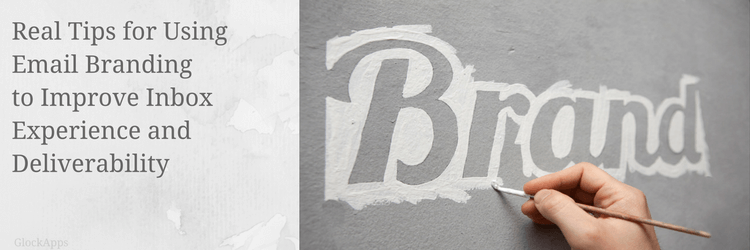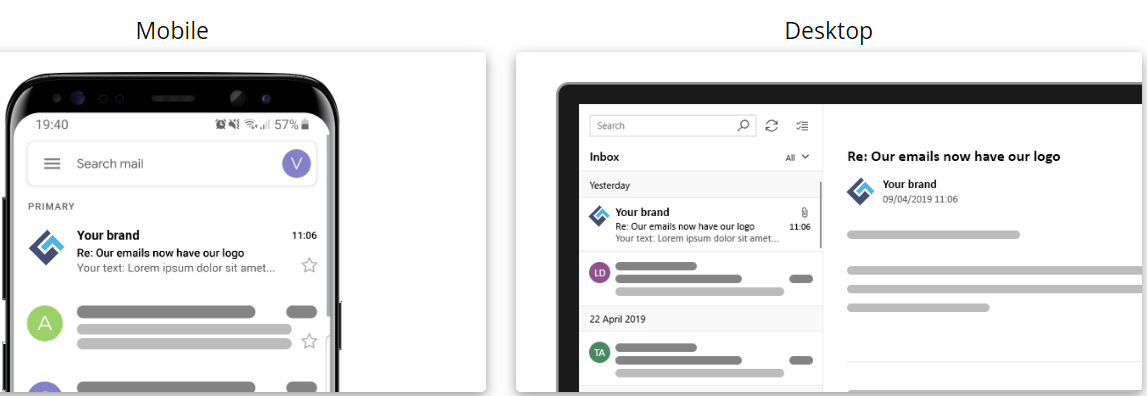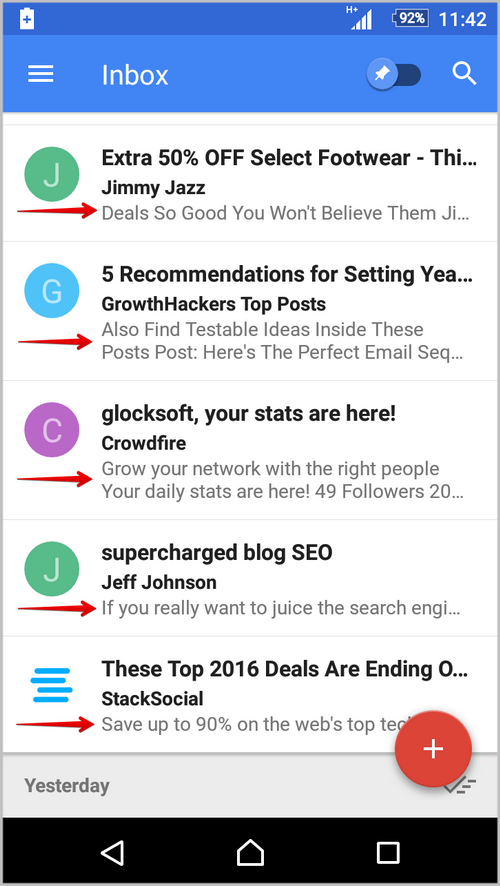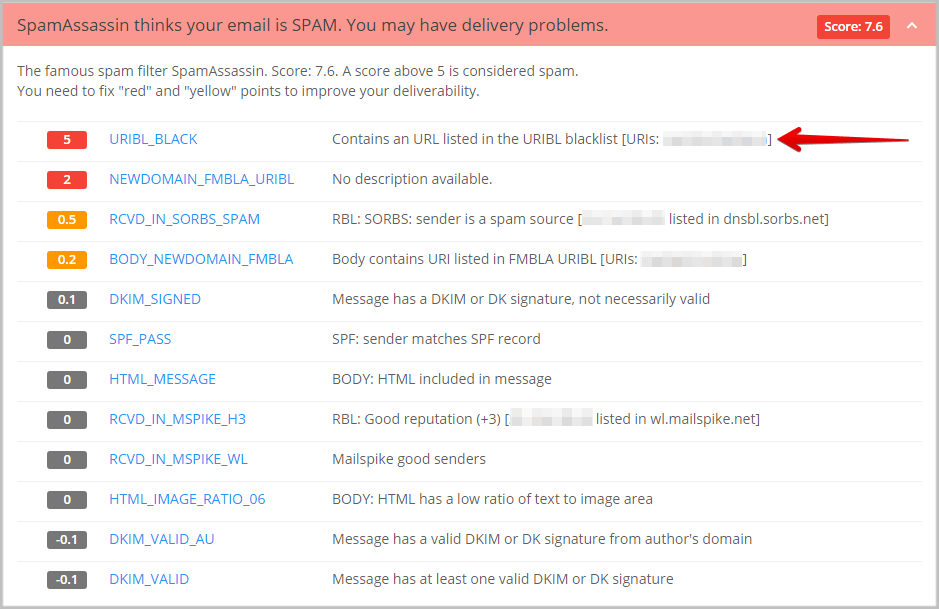Email Branding for Better Inbox Experience and Deliverability

According to the latest benchmark report, email conversion rates are higher than social media, direct traffic, and search. Email is alive and continues to be a great channel of communication and marketing for companies who run a business online.
In this post, we are going to focus on the elements of the email that you can use to build trust with your email recipients and improve their engagement.
1. What is Email Branding?
In an email-marketing world, your brand domain is like your identity in real life. It allows the recipients of your marketing and transactional emails to recognize your messages, builds trust and relationships with your recipients and customers.
Just as you brand your products, promotional items, your website, and social media, you can brand emails. There is a variety of options for email branding: add your logo to the message, add branding to the ‘From’ field, subject line, preview, and links. It is proved to be easy, inexpensive, and beneficial for your email marketing.
2. Benefits of an Email Branding
It is one of the most cost-effective and easy-to-implement ways to promote your company. Apart from this, here are undeniable benefits of branding your email messages:
- Good first impression. When the recipient sees your email for the first time, branding plays a key role in introducing you as a professional company worth connecting with.
- Brand awareness. Each sent email reminds the recipient of your company. It stands out in the sea of blank or generic messages and serves as an efficient means to build a relationship with prospects.
- Credibility and trust. Nowadays, people are aware of scams, widespread within email communications. Email branding, together with email authentication, is a surefire way to build trust and prove your identity as a sender.
3. 5 Tips for Developing Your Email Branding Strategy
Now let’s talk specifics: what parts of the email can you brand and how to do it.
1. Brand Your “From” Name for Better Subscriber Experience
The ‘From’ field, Subject line, and preview text are the things that create the first impression about you. It often determines how the subscriber will interact with further messages from you.
Imagine that the average email user receives 200 emails per day. It’s email chaos, so clearly identifying yourself and the purpose of the email helps you cut through the Inbox noise.
Ideally, your “From” field should:
- Be branded with your company name to increase the likelihood of an open.
- Be subscriber friendly, intuitive, and consistent. In addition to your customers, internet service providers (ISPs) prefer to see stability in the ‘From’ Address.
- Reinforce the recipient’s trust in your brand and email stream.
- Provide an instant insight as to the nature of the message you sent (e.g., support, billing, newsletter).
- Increase the chance for the message being discovered, even if it lands in the spam or promotions tab instead of a primary inbox.
- Increase the probability of the subscriber adding your email address to their address book, whitelist, or safe sender list.
- Help the subscriber search and sort messages.
Here is a good email spam checker that you can use to test different ‘From’ fields and see if your ‘From’ field has any impact on your deliverability.
Is it possible to use a free email service address as the “From” address?
It is possible but not recommended if you want to achieve higher deliverability and open rate. The DMARC authentication policies implemented by major free mailbox providers like Gmail, Yahoo!, and AOL can affect the deliverability of emails sent by other SMTP servers and email service providers, so our recommendation is to use a “From” address on your brand domain.
Don’t have a domain yet? Learn how to register one here.
If you are mailing to U.S. subscribers, according to a CAN-SPAM law, your “From” address and “Reply-To” address “must be accurate and identify the person or business who initiated the message”. Canada requires the sender to identify itself and the persons on whose behalf a commercial electronic message is sent.
In the E.U., disguising or concealing the identity of the sender on whose behalf the communication is sent is strictly prohibited.
Is it possible to use a “No-Reply” email address as the “From” address?
In the U.S. sending emails from a “No-Reply” address is legal and some state government organizations do it simply because they don’t have to provide the same level of customer service as business organizations.
However, if you are a marketer and email brings you a solid amount of revenue, you should avoid “No-Reply” email addresses in your email communications no matter what kind of email you are sending (billing, transaction, marketing, newsletters, support, etc.).
Sending a message from a “No-Reply” address means that you don’t want to hear from your recipients back. It’s bad from both ethical and business point of view.
You want to use a “From” email address that can receive messages for the following five reasons:
1. Easier unsubscribe.
Although you include an unsubscribe link in the footer, some recipients will inevitably be too impatient or lazy to scroll your email down and want to reply with an unsubscribe request. Guess what those subscribers are likely to think once they see you don’t let them reply?
Important note: if you know or suspect that your subscriber base includes recipients from the European Union, you must send from a valid address to which the recipient can reply with a request to unsubscribe. You can learn more about global email regulations here.
2. Whitelisting.
It certainly is not tempting for a subscriber to add an email address starting with “no-reply@” to their address book or whitelist. And with the average user being served 200+ emails per day, making it easier to get to the Inbox sounds like common sense.
3. List cleaning.
By some responses, you’ll be able to see if an address is still valid. For example, an auto-responder might send you a notification that a person is no longer at the company. A receiving mail server will send you a bounce email notification if the email address doesn’t exist anymore. Bounced emails are typically sent to your “Return” email address, but some servers send it to your “From” address. Thus, by processing the replies, you’ll be able to remove invalid addresses and update contact information in your subscriber base.
4. Engagement.
As mailbox providers consider recipient interaction with email, replies included, as a positive signal, in our opinion, you should take every opportunity to offer a recipient a better engagement with a message.
5. Likelihood of an open.
Adding a bit of your personality to your marketing communications by asking people to reply in case they have any questions or thoughts to share is something that is always appreciated. It also increases the likelihood of an open for your future messages.
2. Put Your Trusted Logo on the Email Your Subscribers Receive
Linking your “From” email address to a Gravatar can increase open rates and make you stand out in today’s cluttered Inboxes because it will be shown in some email clients.

Signup for Gravatar and upload an image, for example, your brand logo.
It’s free and takes a minute.
Brand Indicators for Message Identification (BIMI) is a new standard for verifying your brand. It helps your visibility by displaying your logo next to your message in the Inbox. Apart from this, BIMI is designed to prevent fraudulent emails and harmful scams that pretend to be from you. Protecting your brand with BIMI improves your deliverability and safeguards your email subscribers from fraudulent emails.

There are a few key things to keep in mind when setting up BIMI for your brand:
- The BIMI standard requires DMARC authentication to be in place at a policy level of ‘quarantine’ or reject’.
- You must create and upload an SVG file for your logo.
- Your logo must be registered with the trademark office.
- You need to have access to your domain DNS to publish a new BIMI DNS entry.
- You need to have a VMC certificate.
When a mail application/client uses BIMI, it first checks if the message passed DMARC alignment.
If the DMARC alignment has passed and the DMARC policy is set to “quarantine” or “reject”, the mail application/client then looks for a BIMI assertion record at the email “From” domain. This record points the mail client to your company’s logo (SVG file) publicly hosted on a web server, which is then displayed in the mail client’s user interface, next to the message “From” information.
To set up BIMI, host an SVG file at a publicly accessible HTTPS URL, then add a BIMI assertion TXT record to your domain DNS, like this one:
default._bimi.example.com TXT "v=BIMI1; l=https://domainmail.com/company-logo.svg"
If the referenced SVG file is in a GZIP-compressed form (SVGZ file), the extension “svgz” is utilized.
For BIMI to work, it’s important to review your DMARC record. In case of any problems within the record, your logo won’t be visible. For example, Gmail won’t render the image if your DMARC record doesn’t have the correct setting (p=quarantine or p=reject).
Creating a BIMI record and publishing it to the domain DNS per the instructions does not automatically show your logo in all customer Inboxes. At this time, only a limited number of Inbox providers support BIMI. However, a wide range of Inbox providers has participated in creating the standard and is likely to add BIMI support soon.
Microsoft has its own non-BIMI beta process for validating and displaying logos called Business Profiles.
A BIMI assertion TXT record requires a VMC certificate to ensure that corporate logos are not used fraudulently. A Verified Mark Certificate (VMC) is a new type of digital certificate that proves the authenticity of a logo tied to an email sender’s domain.
A BIMI record with VMC will include the “a=” tag with the path of your VMC certificate file (.pem). Example:
default._bimi.example.com TXT "v=BIMI1; l=https://domainmail.com/company-logo.svg;
a=https://domainmail.com/company-logo.pem"
Learn more about BIMI: What is BIMI: Ultimate Guide to BIMI in 2023
3. Brand Your Subject Line and Preview Text for Better Engagement
The Subject line is another element that might determine what a recipient wants to do with an email. A good Subject line can bring you a new customer while a bad one can make you lose a subscriber and even generate a complaint.
Thus, you need to pick the words for your Subject lines wisely. After all, you are asking recipients to spend time on your email.
While a lot of information about writing efficient Subject lines exist, some sources are actually sharing the wrong strategies that have been overused and became ineffective.
Examples of such overused tactics can be Subject lines like:
“Quick question”, “Quick request” – people are too busy to take time for thinking and responding. It’s easier to ignore.
“Are you the appropriate person?” – you don’t know who you’re contacting, heh?
“Hey, John (Mary, Julia, David or someone)” – a lot of mass emails hide behind such a seemingly personal subject line. You’ll want to save a greeting for the body.
“You are invited to a seminar (or something)”, “Your exclusive coupon (or something).” Instead of just telling them they’re invited, hint them why they should attend the event or take your offer.
To check and optimize the subject line you can use the Subject line tester.
In our opinion, the best formula for writing an efficient Subject line is
branding + human approach + what email is about
Let’s dive into the details:
Branding.
Adding your brand name or your name if you are an individual marketer to the Subject line quickly forms the recognition.
Some email recipients look through emails by their Subject lines. Using your brand will help your recipients quickly identify your emails among the crowd. It also allows you to easily search for your emails in their Inbox and archive them to a special folder.
Human approach.
Show you are a human. It’s recommended to keep the Subject line short, but there’s nothing wrong with using a complete sentence and adding function words and punctuation marks, if appropriate.
Though your content should be subscriber-focused, you can add a little bit of your personality to the Subject line to show that there is a real person behind the scene. Subject lines that have a look and feel that they are written by a human being have more chances to prompt an open than generic ones.
What email is about.
The best Subject line is one that hints on the email content. It’s good to add some intrigue to the Subject line, but it should make sense. If the sense is lost somewhere in the body of the email, the recipient is more likely to be annoyed than intrigued.
Some may think that you’re trying to trick them to make an open, that’s just going to make them avoid your future messages altogether.
Examples of good Subject lines combining all the above elements could be:
“[GlockApps] I Have an Idea about Our Service I Want to Discuss”
“[GlockApps] I Have News about the Upcoming Release. Please, read…”
“[GlockApps] My New Post “How to Land in the Gmail’s Inbox” is published. Check It Now”
Here you can learn more tips about writing Subject lines.
Optimize the Preview Text to Complement the Subject Line
In every Inbox, a recipient sees the ‘From’ name and the Subject line of an email. Many email clients also show some preview text – text that follows the Subject line.
When it comes to deliverability, you should use every opportunity to optimize your email for improving the open rate. Preview text is just one of those elements that might determine whether a recipient will open the message.
Preview text is a snippet pulled from the first few lines of the email body and typically displayed on the right or underneath the ‘From’ name and Subject line in a recipient’s Inbox. It is also called a snippet text or a pre-header.

As we said, not all email applications display the preview text. Even if they do, the length of the displayed preview text is not the same.
Below is a quick overview of email clients that support the preview text and the number of characters they display:
Desktop applications:
Apple Mail (140 chars)
Outlook 2013 and 2016 (35 chars)
Mobile applications:
Android Native App (40 chars)
Android Gmail App (depends on the subject line length)
Android Yahoo! App (depends on the subject line length)
iOS Native App (90 chars)
iOS Gmail App and iOS Yahoo! App (50 chars)
Windows Phone (40 chars)
Webmail clients:
AOL (75 chars)
Gmail (depends on the subject line length)
Yahoo! (depends on the subject line length)
If the above email clients are popular among your recipients, pay attention to the optimization of the title and/or first sentences of the email body that will be displayed as the preview text. Outlook.com, Lotus Notes, BlackBerry, and older versions of Outlook don’t support the preview text.
Below are a number of tips you can keep in mind when optimizing the preview text:
One More Subject Line.
Consider the preview text another Subject line and use a similar approach to improve your open rate. Make it useful, specific, complementing the “primary” Subject line and, if appropriate, add a sense of urgency, humor, or exclusivity.
This is also a great place to experiment with personalization, symbols, or other tactics that you aren’t ready to use in the Subject line.
Click here for a web version”? No, no, no.
In many email messages, the preview text asks a recipient to click the link to see the web version of the message, requests a recipient to add the sender to their contact list, or provides the unsubscribe link.
These ancillary elements are good and should be in your email, but somewhere else as they don’t directly tell “Read me!!!”
None of these elements tells the recipient what the email is about, leaving them to decide on the subject line alone.
If that’s what your recipients see in the top line, you’re losing another opportunity to stand out in the crowd and make the reader stop at your message.
Branding is welcomed.
Preview text gives you another chance to build brand recognition and relevancy beyond the Subject line alone.
If you don’t use your brand name in the Subject line itself, you can brand your preview text to reinforce the From name.
Also, don’t forget about length limitations, and stuff the beginning of your preview text with your best keywords and phrases. Don’t make it too short either as you want it to take all the space displayed in iOS Inboxes and Apple Mail. It should be a smart balance.
Get creative as a correctly worded preview text adds value to the message, arouses interest and excitement, and helps your reader decide whether to read the message immediately, save it for later reading or delete it without opening.
4. Develop a Unique Voice for Your Email Copy
The message content has to be not only compelling and valuable to your client – it has to be consistent. This is especially important for big companies, where emails are written by more than just one person.
Imagine receiving old-school snail mail letters from one person, but with different handwriting. It doesn’t feel right, more than that, it feels inconsistent and even suspicious. When reading your messages, the recipient wants to feel like he’s talking to one same person: with the same character, same approach, and same manner of speech. That is why developing a consistent and unique tone of voice for your emails is well worth the effort.
5. Brand Your Links for Better Deliverability
Our final chapter is dedicated to links you might use in your message.
We decided to focus on links because they often affect email deliverability and can become a decisive factor that determines where the email is placed: Inbox or Spam.
While the optimization of the ‘From’ field, the Subject line, and preview text is made primarily for the recipient to drive email opens, the optimization of links mostly addresses spam filters your email is likely to go through before getting delivered to the recipient.
Common Issues Related to Links in the Emails
After testing hundreds of emails and reviewing hundreds of reports provided by our GlockApps service, we’ve come up with the list of common issues related to links in the emails. Here they are:
1. Links Are on Blacklisted Domains.
Like IP addresses, domains can be blacklisted if they are known to send spam or were seen in spam emails.
You risk having issues related to links if
- you don’t have your own domain and host files and images on a 3rd party domain,
- you use links created by link shorteners,
- you use tracking links provided by your email service provider.
It’s a funny thing but we saw a lot of reports where the SpamAssassin had given a high spam score to a message because of tracking links provided by email service providers.
Solutions:
- Use links leading to your own domain in the emails.
- Do not use link shortener tools.
Brand tracking links with your domain.
If your ESP does not allow using a custom domain for tracking, there are email tracking services like G-Lock Analytics that allow you to brand all your tracking links with your domain to avoid blocking issues if they are caused by a blacklisted 3rd party domain.Branded links also reinforce trust and make your customers feel more comfortable clicking on a link.
2. Links Are Too Long.
Issues related to a link length most often happen if you are using an email tracking capability for your emails in your email service provider.
Email service providers used to generate a long tracking code and links (2-3 lines) that might be caught by spam filtering systems.
Solutions:
- Use a tracking service like G-Lock Analytics that generates short tracking links and code.
3. Phishing Links.
This is one more issue that is not evident but really harmful for deliverability.
It happens when you use different domains in the visible URL and linked URL.
Spam filters see this behavior as a phishing attempt and increase the likelihood of spam for the message.
Solutions:
- Use the same domain in the visible URL and linked URL.
- Use an anchor text linked to a web page.
Use an email tracking service that allows to brand tracking links with your domain to avoid discrepancy.
Bad URL example:
Good URL example:
4. Too Many Links.
If a message contains too many links, maybe ten or more, it is also a red flag for spam filters and one of the causes why the message is delivered to the Promotions tab at Gmail and other mailbox providers that support Inbox tabs.
Solutions:
- Reduce the number of links in the email to 2-3 most important ones.
Upload your content with a lot of links to a website, create a short email copy with one call-to-action to visit the page.
To know whether or not links in your email are likely to cause deliverability issues, run a spam test at GlockApps.
GlockApps will show you the email spam score given by SpamAssassin with a detailed report about each element that adds points to the spam score. If there are links from blacklisted domains, you will see it there.

GlockApps will also provide troubleshooting tips, e.g. suggestions, about what issues you should address in order to pass through email spam filters and improve your deliverability.
Learn More: How to Write Emails that Convert
GlockApps Spam Testing for Marketers and Agencies

Test your email placement
Scan your emails through all the major spam filters before you send them.
Improve your deliverability
Get actionable tips for improving the delivery rate of every email you send.
Increase your revenue
Improve your overall email performance by delivering more emails to the inbox.






Comments
Thank you very much Julia, you are really knowledgeable:)